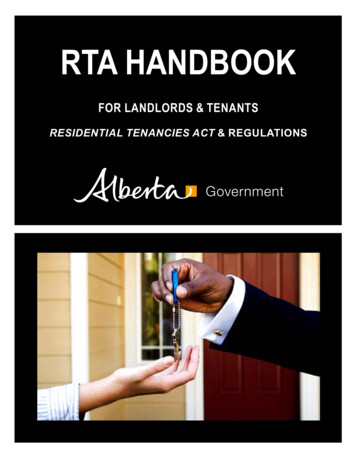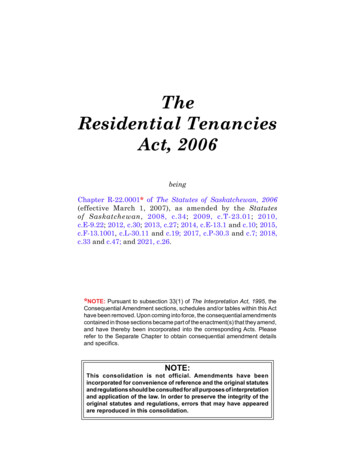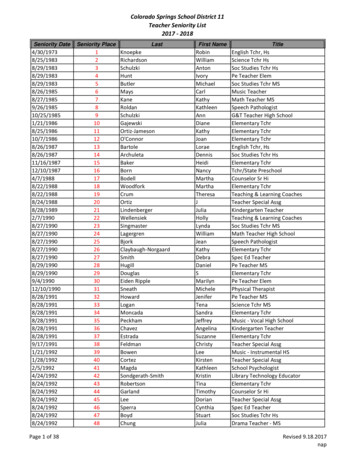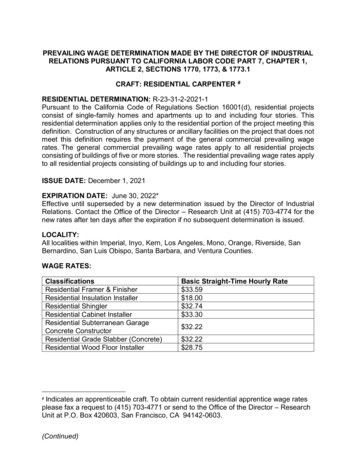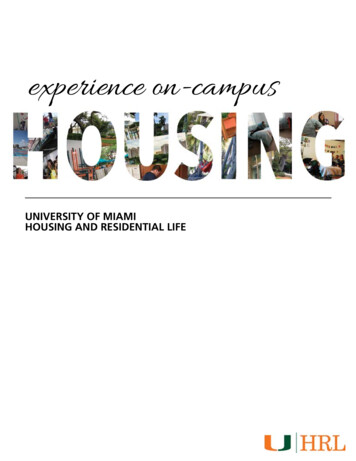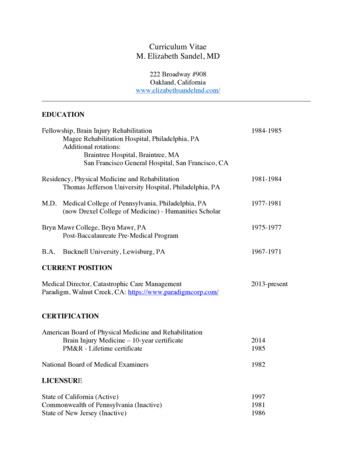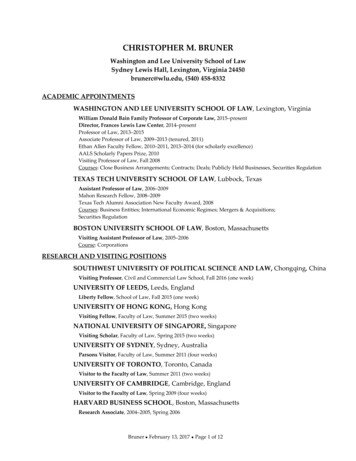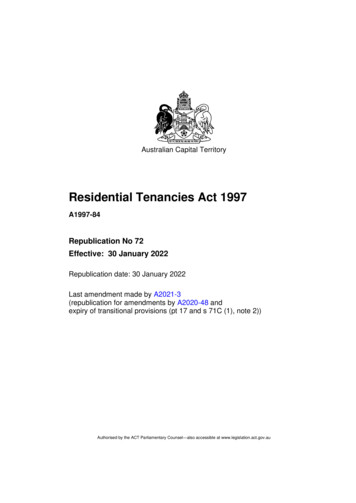
Transcription
Australian Capital TerritoryResidential Tenancies Act 1997A1997-84Republication No 72Effective: 30 January 2022Republication date: 30 January 2022Last amendment made by A2021-3(republication for amendments by A2020-48 andexpiry of transitional provisions (pt 17 and s 71C (1), note 2))Authorised by the ACT Parliamentary Counsel—also accessible at www.legislation.act.gov.au
About this republicationThe republished lawThis is a republication of the Residential Tenancies Act 1997 (including any amendment madeunder the Legislation Act 2001, part 11.3 (Editorial changes)) as in force on 30 January 2022. Italso includes any commencement, amendment, repeal or expiry affecting this republished law to30 January 2022.The legislation history and amendment history of the republished law are set out in endnotes 3and 4.Kinds of republicationsThe Parliamentary Counsel’s Office prepares 2 kinds of republications of ACT laws (see the ACTlegislation register at www.legislation.act.gov.au): authorised republications to which the Legislation Act 2001 applies unauthorised republications.The status of this republication appears on the bottom of each page.Editorial changesThe Legislation Act 2001, part 11.3 authorises the Parliamentary Counsel to make editorialamendments and other changes of a formal nature when preparing a law for republication.Editorial changes do not change the effect of the law, but have effect as if they had been made byan Act commencing on the republication date (see Legislation Act 2001, s 115 and s 117). Thechanges are made if the Parliamentary Counsel considers they are desirable to bring the law intoline, or more closely into line, with current legislative drafting practice.This republication includes amendments made under part 11.3 (see endnote 1).Uncommenced provisions and amendmentsIf a provision of the republished law has not commenced, the symbol U appears immediatelybefore the provision heading. Any uncommenced amendments that affect this republished laware accessible on the ACT legislation register (www.legislation.act.gov.au). For moreinformation, see the home page for this law on the register.ModificationsIf a provision of the republished law is affected by a current modification, thesymbol M appears immediately before the provision heading. The text of the modifyingprovision appears in the endnotes. For the legal status of modifications, see the LegislationAct 2001, section 95.PenaltiesAt the republication date, the value of a penalty unit for an offence against this law is 160 for anindividual and 810 for a corporation (see Legislation Act 2001, s 133).Authorised by the ACT Parliamentary Counsel—also accessible at www.legislation.act.gov.au
Australian Capital TerritoryResidential Tenancies Act 1997ContentsPagePart 11233A44APart 1A566AA6A6B6CR7230/01/22PreliminaryName of ActDictionaryNotesOffences against Act—application of Criminal Code etcApplication of ActObjects of Act222333Meaning of residential tenancy agreementWho is a lessor?Who is a tenant?Who is a co-tenant?What is a residential tenancy agreement?Residential tenancy agreement if agreement written and says it isresidential tenancy agreementResidential tenancy agreement if agreement part of employmentResidential Tenancies Act 1997Effective: 30/01/22Authorised by the ACT Parliamentary Counsel—also accessible at www.legislation.act.gov.au555566contents 1
ContentsPage6D6E7Part 2Certain kinds of agreements not residential tenancy agreementsCertain people given right of occupation not tenantsWhen does residential tenancy agreement start?778Residential tenancy agreementsDivision 2.1Terms of agreement8Standard residential tenancy terms9Inconsistent tenancy terms void10Endorsement of inconsistent tenancy terms by ACAT91212Division 2.2Precontractual obligations11Compliance11AEnergy efficiency rating—advertising11AACertain special conditions must be advertised11AAAAdaptable housing—advertising11BSmoke alarms12Lessor’s obligations13Tenant’s obligations14Agent’s obligations1313141516161818Division 2.3Consideration15Rent or a bond only16Alternative to a bond—guarantee or indemnity18Holding deposits182020Division 2.4Lessor’s obligations on signing agreement19Copy of agreement to be given to tenant21Part 3BondsDivision 3.1Payment of bonds20Maximum amount payable21Only 1 bond per residential tenancy agreement22Successive residential tenancy agreements222222Division 3.2Depositing bond23Deposit of bond by lessor24Deposit of bond by tenant25Notice about deposit26Acknowledgment of receipt of bond money23242425contents 2Residential Tenancies Act 1997Effective: 30/01/22Authorised by the ACT Parliamentary Counsel—also accessible at www.legislation.act.gov.auR7230/01/22
ContentsPage2728Payment of bond money into trust accountInterest on amounts in trust account2525Division 3.3Condition of premises and deductions from bond29Condition report—start of tenancy30Evidence of condition of premises30AFinal inspection and condition report—end of tenancy31Deductions from bond26272728Division 3.4Release of bond money32Definitions—div 3.433Bond release application—general34Bond release application—lessor’s obligations34ABond release application—joint application34BBond release application—application by tenant34CBond release application—application by lessor34DBond release application before end of agreement34EBond release application—ACAT order34FBond release application—discrepancy in named tenant35Disputes about all or part of bond29292930313233343435Part 3A35A35B35C35D35E35F35GPart 4Co-tenanciesCo-tenant may leave residential tenancy agreementRepayment of bond to leaving co-tenantBecoming a co-tenant under existing residential tenancy agreement—generallyCo-tenancy on application to ACATBecoming a co-tenant under existing residential tenancy agreement—social housing dwelling and crisis accommodationPayment of bond by new co-tenantACAT orders—co-tenancy matters3840424243Termination of residential tenancyagreementsDivision 4.1General36Termination37Entry for eviction purposes38General duty to mitigateR7230/01/223637Residential Tenancies Act 1997Effective: 30/01/22Authorised by the ACT Parliamentary Counsel—also accessible at www.legislation.act.gov.au454747contents 3
ContentsPage39Content of termination and possession orders48Division 4.2Warrants for eviction40Content of warrant41Warrant—termination and possession order4849Division 4.3Termination initiated by tenant43Breach of standard residential tenancy terms44Significant hardship45Damage, injury or intention to damage or injure46False or misleading statements46ATermination of agreement for aged care or social housing needs46BTermination of fixed term agreements if premises for sale495052525253Division 4.4Termination initiated by lessor47No breach of standard residential tenancy terms48Certain breaches of standard residential tenancy terms49Failure to pay rent—termination and possession order49AFailure to pay rent—payment order49BFailure to comply with payment order49CHearing of application—failure to comply with payment order50Significant hardship51Damage, injury or intention to damage or injure52False or misleading statements53Employer-provided accommodation54Purported co-tenancy, assignment or subletting55Repudiation without vacation55AAffected residential premises55BEligible impacted property56Compensation to lessor57Retaliatory on 4.5Defective termination notices58Lessor’s defective notice if tenant vacates59Lessor’s defective notice if tenant does not vacate60Tenant’s defective termination notice686970Division 4.6Abandonment of premises61Effect of abandonment70contents 4Residential Tenancies Act 1997Effective: 30/01/22Authorised by the ACT Parliamentary Counsel—also accessible at www.legislation.act.gov.auR7230/01/22
ContentsPage61A6263Lessor may enter premises to confirm abandonmentAbandonment during fixed termAbandonment during periodic agreement717172Division 4.7Miscellaneous64Successor in title to lessor64AATermination—affected residential premises64ABTermination—eligible impacted property64ACNo new residential tenancy agreements etc for affected residentialpremisesPart 564A64B64C65666868A697071Part 5A71A71B71C71CAR7230/01/2275Rental rate increasesStandard residential tenancy term—increase in rentLimitation on rent increasesTenant may apply for reviewWaiver of notice requirementsFreezing rentsGuideline for ordersOrdersEffect of ordersFurther increasesReduction of existing rentPart 9798080Lessor’s consent in certain mattersDefinitions—pt 5AAProcess for tenant seeking consent—modifications generallyLessor to apply to ACAT for refusal—special modificationsTenant may apply to ACAT for review of refusal—other modificationsProcess for tenant seeking consent—animalsLessor to apply to ACAT for refusal—animalsLimitation on lessor’s liability82838484868687Occupancy agreementsWho is a grantor?Who is an occupant?What is an occupancy agreement?Certain types of agreements not occupancy agreementsResidential Tenancies Act 1997Effective: 30/01/22Authorised by the ACT Parliamentary Counsel—also accessible at www.legislation.act.gov.au88888891contents 5
71EH71EI71EJ71EK71EL71EM71FPart 5BOccupancy agreement—smoke alarmsWhen does an occupancy start and end?Application of occupancy principlesOccupancy principlesCondition reportPayment of security depositSecurity deposit must be lodged with TerritoryDeductions from security depositReceipts for certain paymentsOccupancy rules, fees, charges and penaltiesOccupant’s access to occupancy premisesInformation about dispute resolution processesEntry by grantor to occupancy premisesTermination of occupancy agreementWarrant for eviction—vacant possession orderOccupancy agreement—abandonment of premisesRegulations about occupancy 06Residential parksDivision 5B.1Definitions—pt 5B71HDefinitions—pt 5B107Division 5B.2Shared park facilities71IAccess to shared park facilities107Division 5B.3Assignment of interests71JDefinitions—div 5B.371KAssignment in residential park permitted with consent71LConsent to assignment71MEffect of assignment108108108109Division 5B.4Sale of manufactured homes and mobile homes71NSale of home located on residential park site71OHome to be removed from park if no site agreement once sold109110contents 6Residential Tenancies Act 1997Effective: 30/01/22Authorised by the ACT Parliamentary Counsel—also accessible at www.legislation.act.gov.auR7230/01/22
ContentsPagePart 6Resolution of residential tenancy andoccupancy disputesDivision 6.1Important concepts72Meaning of tenancy dispute73Meaning of occupancy dispute74Other options for dispute resolution112112112Division 6.2Action by registrar75Assistance with inquiries about residential tenancy and occupancyagreements113Division 6.3767778Jurisdiction of ACAT—this Act, standard residentialtenancy terms and standard occupancy termsJurisdiction of ACAT under this Act etcSaving of court jurisdictionExtended jurisdiction of ACAT with agreement of parties114115115Division 6.4Applications to ACAT79Who may apply to ACAT?80Applications to ACAT by children—application of this Act etc117117Division 6.5Powers and decisions of ACAT81ACAT to assist parties to tenancy and occupancy disputes82Disputes about agreements no longer in force83Orders by ACAT84Notice of intention to vacate—award of compensation117117118120Division 6.5APowers and decisions of ACAT—protection orders85Definitions—div 6.5A85ANew tenancy agreement—family violence and protection orders85BApplications under s 85A—ACAT orders121122124Division 6.6Enforcement of ACAT orders86Failure to comply with ACAT orders125Part 787888990R7230/01/22Residential tenancy databasesDefinitions—pt 7Application—pt 7Notice of usual use of databaseNotice of listing if database usedResidential Tenancies Act 1997Effective: 30/01/22Authorised by the ACT Parliamentary Counsel—also accessible at www.legislation.act.gov.au127129129130contents 7
ContentsPage919293949596979899100101Part 8102103104105106Part 9126127127A128131132133134136Part 16156contents 8Listing can be made only for certain breaches by certain peopleFurther restriction on listingEnsuring quality of listing—lessor’s or agent’s obligationEnsuring quality of listing—database operator’s obligationProviding copy of personal information listedNotifying relevant non-parties of tribunal order about listingKeeping personal information listedApplication to ACAT about contraventionApplication to ACAT about certain personal information listed inresidential tenancy databaseApplication to ACAT about proposed listing of personal informationOrder for tration of standard guarantee contractfor commercial guaranteeMeaning of commercial guarantee and standard guarantee contractApplication for registration of standard guarantee contractCommissioner must decide applicationRegister of standard guarantee contractsRelationship to Australian Consumer Law (ACT)140140141142142MiscellaneousDeclared crisis accommodation providerDeath of co-tenantTransfer of public housing under willPurported co-tenancy, assignment or sublettingProceedings by childrenEnforcing agreements by or against childrenApproved forms—MinisterDetermination of feesRegulation-making power143143143144144145145145145COVID-19 emergency responseDeclaration—COVID-19 emergency responseResidential Tenancies Act 1997Effective: 30/01/22Authorised by the ACT Parliamentary Counsel—also accessible at www.legislation.act.gov.au148R7230/01/22
ContentsPageSchedule 1Standard residential tenancy 231R7230/01/22About the endnotesAbbreviation keyLegislation historyAmendment historyEarlier republicationsExpired transitional or validating provisionsResidential Tenancies Act 1997Effective: 30/01/22Authorised by the ACT Parliamentary Counsel—also accessible at www.legislation.act.gov.aucontents 9
Australian Capital TerritoryResidential Tenancies Act 1997An Act relating to residential tenancies and occupancy agreementsR7230/01/22Residential Tenancies Act 1997Effective: 30/01/22Authorised by the ACT Parliamentary Counsel—also accessible at www.legislation.act.gov.aupage 1
Part 1PreliminarySection 1Part 11PreliminaryName of ActThis Act is the Residential Tenancies Act 1997.2DictionaryThe dictionary at the end of this Act is part of this Act.Note 1The dictionary at the end of this Act defines certain terms used in thisAct, and includes references (signpost definitions) to other terms definedelsewhere.For example, the signpost definition ‘energy efficiency ratingstatement—see the Construction Occupations (Licensing) Act 2004,s 123AC’ means that the term ‘energy efficiency rating statement’ isdefined in that section and the definition applies to this Act.Note 23A definition in the dictionary (including a signpost definition) applies tothe entire Act unless the definition, or another provision of the Act,provides otherwise or the contrary intention otherwise appears (seeLegislation Act, s 155 and s 156 (1)).NotesA note included in this Act is explanatory and is not part of this Act.Notepage 2See the Legislation Act, s 127 (1), (4) and (5) for the legal status of notes.Residential Tenancies Act 1997Effective: 30/01/22Authorised by the ACT Parliamentary Counsel—also accessible at www.legislation.act.gov.auR7230/01/22
PreliminaryPart 1Section 3A3AOffences against Act—application of Criminal Code etcOther legislation applies in relation to offences against this Act.4Note 1Criminal CodeThe Criminal Code, ch 2 applies to all offences against this Act (seeCode, pt 2.1).The chapter sets out the general principles of criminal responsibility(including burdens of proof and general defences), and defines terms usedfor offences to which the Code applies (eg conduct, intention,recklessness and strict liability).Note 2Penalty unitsThe Legislation Act, s 133 deals with the meaning of offence penaltiesthat are expressed in penalty units.Application of ActThis Act does not apply in relation to—(a) accommodation provided by an approved provider under theAged Care Act 1997 (Cwlth); or(b) premises prescribed by regulation.4ANote 1A reference to an Act includes a reference to the statutory instrumentsmade or in force under the Act, including a regulation (see LegislationAct, s 104).Note 2The Aged Care Act 1997 (Cwlth) is accessible at www.legislation.gov.au.Objects of ActIn recognition of the importance of stable and secure housing forpeople in the ACT community, the main objects of this Act are to—(a) define the rights and obligations of tenants and lessors underresidential tenancy agreements; and(b) set out minimum contractual requirements for occupancyagreements; andR7230/01/22Residential Tenancies Act 1997Effective: 30/01/22Authorised by the ACT Parliamentary Counsel—also accessible at www.legislation.act.gov.aupage 3
Part 1PreliminarySection 4A(c) enable prospective tenants and occupants to make informedchoices; and(d) ensure that parties to residential tenancy agreements andoccupancy agreements can easily access suitable, low cost,informal and timely ways to enforce their rights under thoseagreements; and(e) protect parties to residential tenancy agreements and occupancyagreements from unfair practices; and(f) facilitate the availability of stable and secure housing in theACT.page 4Residential Tenancies Act 1997Effective: 30/01/22Authorised by the ACT Parliamentary Counsel—also accessible at www.legislation.act.gov.auR7230/01/22
Meaning of residential tenancy agreementPart 1ASection 5Part 1A5Meaning of residential tenancyagreementWho is a lessor?(1) A person is a lessor if the person grants a right of occupation under aresidential tenancy agreement.(2) Lessor includes a prospective lessor.6Who is a tenant?(1) A person is a tenant if the person has a right of occupation under aresidential tenancy agreement.(2) Tenant includes a prospective tenant.6AAWho is a co-tenant?A person is a co-tenant under a residential tenancy agreement if theperson is 1 of 2 or more tenants under the agreement.Note6ASection 35C sets out how a person can become a new co-tenant under anexisting residential tenancy agreement.What is a residential tenancy agreement?(1) An agreement is a residential tenancy agreement if—(a) under the agreement—(i) a person gives someone else (the tenant) a right to occupystated premises; and(ii) the premises are for the tenant to use as a home (whetheror not together with other people); and(iii) the right is given for value; and(b) the agreement is not an occupancy agreement undersection 71C.R7230/01/22Residential Tenancies Act 1997Effective: 30/01/22Authorised by the ACT Parliamentary Counsel—also accessible at www.legislation.act.gov.aupage 5
Part 1AMeaning of residential tenancy agreementSection 6B(2) The agreement may be—(a) express or implied; or(b) in writing, oral, or partly in writing and partly oral.(3) The right to occupy may be—(a) exclusive or not exclusive; and(b) given with a right to use facilities, furniture or goods.(4) This section is subject to the following sections: section 6D (Certain kinds of agreements not residential tenancyagreements) section 6E (Certain people given right of occupation not tenants).6BResidential tenancy agreement if agreement written andsays it is residential tenancy agreementDespite section 6A (4), an agreement is a residential tenancyagreement if it—(a) complies with section 6A (1) to (3); and(b) is in writing; and(c) expressly states that it is a residential tenancy agreement.6CResidential tenancy agreement if agreement part ofemploymentDespite section 6A (4), an agreement mentioned in section 6A (1)to (3) is a residential tenancy agreement if the person who is giventhe right to occupy the premises occupies the premises as the person’shome under the terms and conditions of the person’s employment.page 6Residential Tenancies Act 1997Effective: 30/01/22Authorised by the ACT Parliamentary Counsel—also accessible at www.legislation.act.gov.auR7230/01/22
Meaning of residential tenancy agreementPart 1ASection 6D6DCertain kinds of agreements not residential tenancyagreements(1) A residential tenancy agreement does not include an agreement—(a) arising under a mortgage entered into honestly in relation to thepremises; or(b) arising under a scheme if—(i) a group of adjacent premises is owned by a company; and(ii) the tenants who have rights to occupy the adjacentpremises are people who jointly have a controlling interestin the company; or(c) entered into honestly to provide a right to occupy the premisesfor a holiday; or(d) prescribed by regulation.(2) This section is subject to the following sections: section 6B (Residential tenancy agreement if agreement writtenand says it is residential tenancy agreement) section 6C (Residential tenancy agreement if agreement part ofemployment).6ECertain people given right of occupation not tenants(1) A residential tenancy agreement does not include an agreement forthe right to occupy premises if the person given the right ofoccupation is—(a) a party to an agreement entered into honestly for the sale orpurchase of the premises; or(b) a person prescribed by regulation.R7230/01/22Residential Tenancies Act 1997Effective: 30/01/22Authorised by the ACT Parliamentary Counsel—also accessible at www.legislation.act.gov.aupage 7
Part 1AMeaning of residential tenancy agreementSection 7(2) This section is subject to the following sections: section 6B (Residential tenancy agreement if agreement writtenand says it is residential tenancy agreement) section 6C (Residential tenancy agreement if agreement part ofemployment).7When does residential tenancy agreement start?A residential tenancy agreement starts on the earliest of the followingdays:(a) the day stated in the agreement;(b) the 1st day both parties have signed the agreement and receiveda copy signed by the other;(c) the day the tenant takes possession of the premises;(d) the 1st day the lessor receives rent from the tenant.page 8Residential Tenancies Act 1997Effective: 30/01/22Authorised by the ACT Parliamentary Counsel—also accessible at www.legislation.act.gov.auR7230/01/22
Residential tenancy agreementsTerms of agreementPart 2Division 2.1Section 8Part 2Residential tenancy agreementsDivision 2.1Terms of agreement8Standard residential tenancy terms(1) A residential tenancy agreement—(a) is taken to contain the standard residential tenancy termsmentioned in schedule 1—(i) for a fixed term agreement—as in force on the day theparties enter the agreement; or(ii) for a periodic agreement—as in force from time to time;and(b) if the lessor and tenant agree—may contain a fair clause forposted people; and(c) if the agreement is a fixed term agreement and the lessor andtenant agree—may contain a break lease clause; and(d) may contain any other term—(i) that is consistent with the standard residential tenancyterms; or(ii) that is inconsistent with a standard residential tenancy termif the term has been endorsed by the ACAT undersection 10.(2) Despite subsection (1) (a) (i), an amendment of this Act (other thanschedule 1) that affects the operation of schedule 1 applies to a fixedterm agreement.(3) To remove any doubt, subsection (1) (a) (ii) applies to a periodicagreement that commences on expiry of a fixed term agreement, onthe day the periodic agreement commences.R7230/01/22Residential Tenancies Act 1997Effective: 30/01/22Authorised by the ACT Parliamentary Counsel—also accessible at www.legislation.act.gov.aupage 9
Part 2Division 2.1Residential tenancy agreementsTerms of agreementSection 8(4) In this section:break lease clause means the following clause:Termination before end of fixed term—fee for breakinglease(1)If the tenant ends a fixed term agreement before the end of thefixed term (other than for a reason provided for by theResidential Tenancies Act or the agreement), the tenant mustpay a fee (a break fee) of the following amount:(a) if the fixed term is 3 years or less—(i) if less than half of the fixed term has expired—6 weeks rent; or(ii) in any other case—4 weeks rent;(b) if the fixed term is more than 3 years—the amount agreedbetween the lessor and tenant.(2)The lessor agrees that the compensation payable by the tenantfor ending a fixed term agreement before the end of the fixedterm is limited to the amount of the break fee specified insubclause (1).(3)However, the lessor and tenant agree that if, within thedefined period after the tenant vacates the premises, the lessorenters into a residential tenancy agreement with a new tenant,the amount payable by the tenant is limited to—(a) the amount of the break fee under subclause (1) less theamount of rent payable by the new tenant for the definedperiod; andpage 10Residential Tenancies Act 1997Effective: 30/01/22Authorised by the ACT Parliamentary Counsel—also accessible at www.legislation.act.gov.auR7230/01/22
Residential tenancy agreementsTerms of agreementPart 2Division 2.1Section 8(b) if the tenant vacates the premises more than 4 weeksbefore the end of the fixed term—the lessor’s reasonablecosts (not exceeding the defined cost limit) of advertisingthe premises for lease and of giving a right to occupy thepremises to another person.(4) In this clause:defined cost limit means—(a) if half or more than half of the fixed term has expired—anamount equal to 2/3 of 1 week’s rent; or(b) if less than half of the fixed term has expired—an amountequal to 1 week’s rent.defined period means—(a)if subclause (1) (a) (i) applies—6 weeks; or(b)if subclause (1) (a) (ii) applies—4 weeks; or(c)if subclause (1) (b) applies—N weeks.N is the number worked out as follows:break feeweekly rent payable at the time the tenant ends the agreementfair clause for posted people means the following clause:Termination because of posting(1)The tenancy agreement may be terminated—(a) if the lessor is posted to Canberra in the course of thelessor’s employment—by the lessor giving the tenant atleast 8 weeks written notice; or(b) if the tenant is posted away from Canberra in the courseof the tenant’s employment—by the tenant giving thelessor at least 8 weeks written notice.R7230/01/22Residential Tenancies Act 1997Effective: 30/01/22Authorised by the ACT Parliamentary Counsel—also accessible at www.legislation.act.gov.aupage 11
Part 2Division 2.1Residential tenancy agreementsTerms of agreementSection 9(2)A notice under subclause (1) must be accompanied byevidence of the posting (for example, a letter from theemployer of the lessor or tenant confirming the details of theposting).(3)The tenancy ends—(a) 8 weeks after the day a notice is received undersubclause (1); or(b) if a later date is stated in the notice—on the stated date.9Inconsistent tenancy terms void(1) A term of a residential tenancy agreement is void if—(a) it is inconsistent with a standard residential tenancy term; and(b) it has not been endorsed by the ACAT under section 10.(2) A term of a residential tenancy agreement is void if it is inconsistentwith this Act (other than a standard residential tenancy term).10Endorsement of inconsistent tenancy terms by ACAT(1) The parties to a residential tenancy agreement may apply in writingto the ACAT for endorsement of a term of the agreement (theinconsistent term) that is inconsistent with a standard residentialtenancy term.(2) If the parties apply for endorsement of the inconsistent term, theACAT must do 1 of the following:(a) endorse the inconsistent term;(b) substitute the equivalent standard residential tenancy term forthe inconsistent term.(3) In making a decision under subsection (2), the ACAT mustconsider—(a) the criteria determined under subsection (6); andpage 12Residential Tenancies Act 1997Effective: 30/01/22Authorised by the ACT Parliamentary Counsel—also accessible at www.legislation.act.gov.auR7230/01/22
Residential tenancy agreementsPrecontractual obligationsPart 2Division 2.2Section 11(b) whether the inclusion of the inconsistent term in the residentialtenancy agreement was obtained by fraud or undue influence.(4) The ACAT must not endorse a term that is inconsistent with this Act(other than a standard residential tenancy term).(5) The ACAT must not endorse a term mentioned in section 15 (5) inrelation to a tenant unless satisfied that the tenant owes an amount tothe housing commissioner.(6) The Minister may determine criteria for subsection (3) (a).(7) A determination is a disallowable instrument.NoteA disallowable instrument must be notified, and presented to theLegislative Assembly, under the Legislation Act.Division 2.211Precontractual obligationsCompliance(1) A lessor or tenant, or the agent of a lessor or tenant, must comply withhis or her obligations under this division before the residentialtenancy agreement commences.(2) A person is taken to have complied with an obligation under thisdivision to provide certain information if that information is set outin the residential tenancy agreement being signed by the tenant.11AEnergy efficiency rating—advertising(1) A person commits an offence if—(a) the person publishes an advertisement for the lease of premises;and(b) the advertisement does not contain—(i) if there is an existing energy efficiency rating of thehabitable part of the premises—a statement of the energyefficiency rating; orR7230/01/22Residential Tenancies Act 1997Effective: 30/01/22Authorised by the ACT Parliamentary Counsel—also accessible at www.legislation.act.gov.aupage 13
Part 2Division 2.2Residential tenancy agreementsPrecontractual obligationsSection 11AA(ii) if there is no existing energy efficiency rating statement forthe habitable part of the premises—a statement to thateffect.Maximum penalty: 5 penalty units.(2) Subsection (1) does not apply if the person has a reasona
Authorised by the ACT Parliamentary Counsel—also accessible at www.legislation.act.gov.au . About this republication . The republished law . This is a republication of the . Residential Tenancies Act 1997 (including any amendment made under the . Legislation Act 2001, part 11.3 (Editorial changes)) as in force on 30 January 2022. It
